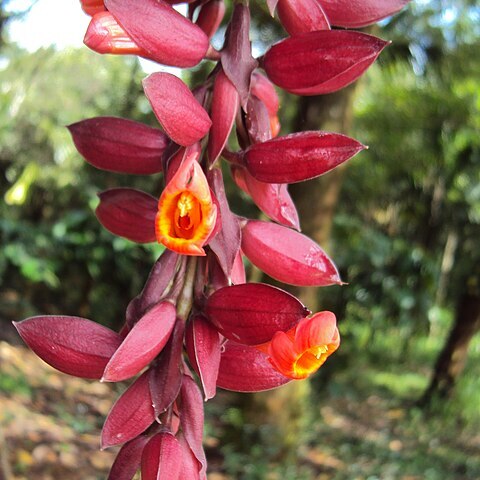Vines, woody. Stems 9-angled, subglabrous, pubescent at nodes. Petiole 2-7 cm, grooved; leaf blade broadly ovate, ovate, or lanceolate, 8-15 × 3.5-11 cm, both surfaces pubescent, palmately 3-5-veined, base rounded to cordate, margin undulate or remotely toothed, apex acuminate. Racemes axillary or terminal, to 35 cm, pendulous; peduncle 3-4 cm, pubescent; bracts lanceolate, abaxially pubescent, adaxially glabrous; bracteoles oblong, 2.2-2.6 × 1.1-1.5 cm, apex acute. Calyx ca. 2 mm, reduced to a minute rim. Corolla red; tube basally cylindric for 5-6 mm, throat 1.5-1.6 cm; lobes suborbicular, ca. 7 mm in diam. Staminal filaments 1.2-1.5 cm, glabrous but with a tuft of trichomes at base; anther thecae parallel, unequal with longer one ca. 5.5 mm and shorter one ca. 4.5 mm, spurred at base. Ovary glabrous; style glabrous, exserted; stigma 2-cleft. Capsule glabrous, basal part 1-1.2 × 1.5-2 cm, beak 1.5-2.3 cm. Seeds compressed, ovate in outline, verrucose. Fl. Sep-Jan, fr. Jan-May. 2n = 20.
More
A climber. It has branches. The bark is pale brown or reddish. The leaves have stalks. The leaves are 7.5-15 cm long by 4-7.5 cm wide. They are oval to oblong and taper to the tip. The edges have wide irregular lobes or blunt teeth. The base is heart shaped or rounded. The flowers are yellow. They are tinged with red outside. They are in drooping clusters near the ends of branches. The fruit is a capsule.

